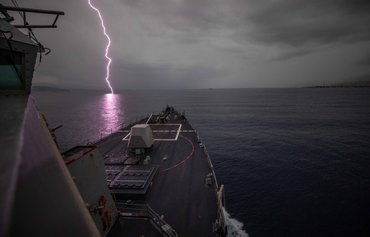French Rafale fighters this month demonstrated France's power projection capabilities with a 4,000km (2,159 nautical miles) flight from the Indian Ocean to Singapore.
While carrying out five days of joint exercises with the Indian Navy from January 16 to 20, the Charles de Gaulle carrier strike group (CSG) on January 17 sent three Rafale fighters to Paya Lebar Air Base in Singapore.
The Rafales were accompanied and supported by an Airbus Multi-role Tanker Transport (MRTT) from France as part of the Rastaban joint power projection exercise with the French Air Force.
The Airbus MRTT has proven to be capable, combat-proven new generation tanker able to conduct air-refueling operations and transport fuel, cargo and personnel.
![Singaporean F-15s and F-16s fly along with French Rafale fighter jets above the South China Sea on January 20. [Singapore Air Force]](/cnmi_am/images/2023/01/25/40395-fm5vrmmaeaaxvzh-600_384.jpg)
Singaporean F-15s and F-16s fly along with French Rafale fighter jets above the South China Sea on January 20. [Singapore Air Force]
![French and Indian military personnel train together on January 19. [French Navy]](/cnmi_am/images/2023/01/25/40400-fm26u2swaa0-hix-600_384.jpg)
French and Indian military personnel train together on January 19. [French Navy]
![A US sailor signals to an F-18 as it taxis along the runway of the USS Nimitz in the South China Sea on January 20. [US Navy]](/cnmi_am/images/2023/01/25/40411-fm6trsxwqaehbpo-600_384.jpg)
A US sailor signals to an F-18 as it taxis along the runway of the USS Nimitz in the South China Sea on January 20. [US Navy]
For its part, the Rafale is a twin-jet fighter aircraft able to operate from both aircraft carriers and shore bases.
It is built for a wide range of combat missions, including air superiority, strikes deep inside adversary territory, reconnaissance, and anti-ship action, and has proven able to fight alongside allies collaborating and communicating in real time, according to its manufacturer Dassault Aviation.
Aviation Weekly describes the flight to Singapore as the Rafale's longest force projection yet.
Power projection
Since late last year, the Charles de Gaulle CSG has been demonstrating the French Navy's ability to conduct complex missions with allied militaries thousands of miles from mainland France.
The CSG is in the Indian Ocean after more than two months of operations in the Mediterranean and Arabian seas as part of Mission Antares, which has involved 3,000 service members from France and allied partners.
The 21st iteration of the naval exercise between India and France, dubbed "Varuna", comprised "advanced air defence exercises, tactical manoeuvres, surface firings, underway replenishment and other maritime operations," according to a statement by the Indian Navy.
Before heading to the Indian Ocean, the Charles de Gaulle was reporting from the Eastern Mediterranean and engaged in combat simulations as part of Operation Inherent Resolve, the international coalition mission to defeat the "Islamic State of Iraq and Syria" (ISIS).
During these exercises, the CSG was teamed up with several US and allied nation naval vessels, including the USS Roosevelt, a destroyer equipped with some of the US Navy's most advanced weaponry that allows the Navy to strike targets located deep in adversarial territory.
The Charles De Gaulle CSG comprises carrier Charles De Gaulle, destroyers Forbin and Provence, and replenishment ship Marne, USNI News reported.
The FREMM-class frigates bring years of award-winning anti-submarine capability to the strike group, among other capabilities.
During the Mediterranean phase of the deployment, the Charles De Gaulle CSG included US Navy destroyer Arleigh Burke, Italian Navy frigate Virginio Fasan and Greek Navy frigate Adrias.
France's robust presence in the Eastern Mediterranean is part of its effort to project power in 2024-2030, as announced by President Emmanuel Macron in November in a speech in Toulon, France.
Macron, in his address, presented France's new strategic review, which the parliament is to consider in 2023, according to the Breaking Defence news site.
"The period is not one of calm weather but stormy seas," he said, referring to the Russian invasion of Ukraine.
The review cites 10 strategic objectives, several of which touch on co-operation such as that seen in the Mediterranean.
They include recognising the need for a "fundamental ... ambitious, lucid and pragmatic" strategic partnership with the United States", cultivating relationships with and in "African nations, the Arabian Gulf, the Mediterranean and the Red Sea and the Indo-Pacific region", and preserving "freedom of action and ability to conduct military operations", among others.
Worries over China
The ongoing exercises in part point to growing concerns over China.
China claims almost all of the South China Sea, through which trillions of dollars in trade passes annually, with competing claims from Brunei, Malaysia, the Philippines, Taiwan and Vietnam.
Beijing has also been pushing a massive infrastructure drive to connect mainland China to the Horn of Africa via a network of military and commercial facilities.
As part of its "String of Pearls" strategy, China's sea lines run through several major ports from the Maldives to Bangladesh, Sri Lanka, Pakistan, Iran and Somalia.
They run through several major maritime choke points including the Bab al-Mandeb Strait (between Yemen on the Arabian Peninsula, and Djibouti and Eritrea in the Horn of Africa), the Strait of Malacca (the main shipping channel between the Indian and Pacific oceans), the Strait of Hormuz (which separates Iran from Oman and the United Arab Emirates) and the Lombok Strait (between the islands of Bali and Indonesia).
Beijing's global infrastructure drive, known as the Belt and Road Initiative (BRI) or One Belt, One Road (OBOR), continues inland from these important seaports, reaching other parts of the Middle East, Central Asia and Africa.
The String of Pearls also gives Beijing an advantage and a pressure lever should a full-scale conflict erupt over Taiwan.

![A French frigate seen sailing alongside the Charles de Gaulle carrier group in January. [French Navy]](/cnmi_am/images/2023/01/25/40394-fngrizoxoaelglb-600_384.jpg)






